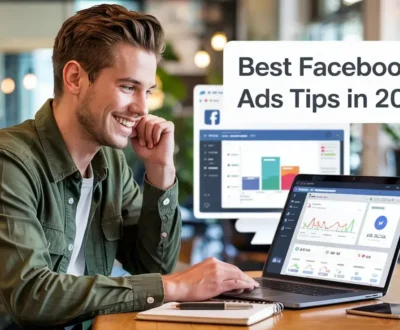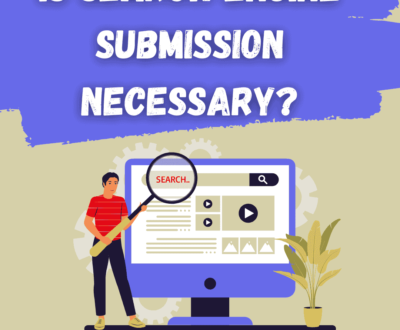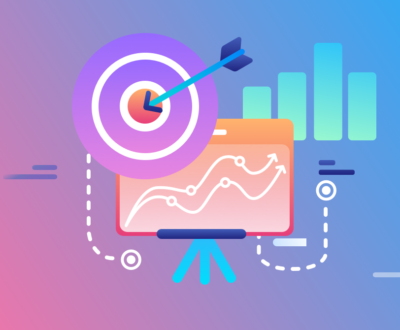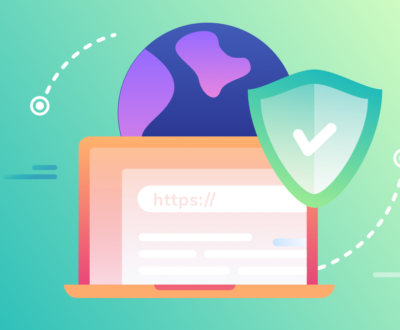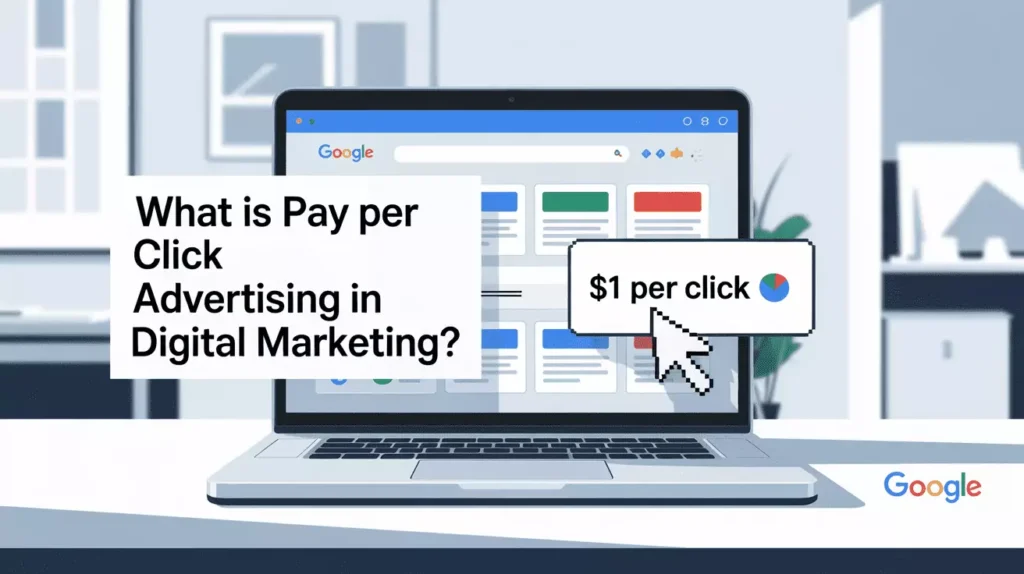
It’s one of the fastest ways to get your business in front of the right people online. Instead of waiting months for SEO to kick in, PPC helps you show up at the top of search results instantly—and you only pay when someone clicks your ad.
Whether you’re a beginner or just curious about how everything works, this simple guide will explain everything you need to know about PPC.
From how it works to why it’s so effective, you’ll learn how pay-per-click ads can boost your traffic, bring in leads, and grow your brand without wasting your budget.
What is PPC?
PPC stands for Pay-Per-Click. It’s online advertising where you only pay when someone clicks on your ad.
Instead of paying just for people to see your ad, like on a billboard or TV, you only pay when someone is interested enough to click. This makes PPC a smart and affordable way to bring real visitors to your website, store, or product.
PPC ads can appear in different places depending on where you advertise. These include:
- Search engines like Google and Bing
- Social media platforms like Facebook, Instagram, TikTok, and LinkedIn
- Banner ads on other websites
- YouTube videos
- Online stores like Amazon and Etsy
Example:
If you’re running a PPC ad for “cat food,” your ad might appear at the top of Google when someone types that into the search bar.
Let’s say you’re paying $1 for each click. If 100 people click on your ad, you’ll spend $100 total.
How Does PPC Work?
PPC (Pay-Per-Click) ads let businesses show their ads when people search for specific words or phrases online. These words are called keywords.
Here’s how PPC works step by step:
- Choose keywords – For example, if you want your ad to show when someone searches “buy running shoes,” you’d use that phrase as a keyword.
- Set your bid – This means telling the platform (like Google) how much you’re willing to pay for each click on your ad.
- Ad appears in search results – If your ad and bid are strong, your ad can show up at the top.
- You only pay when someone clicks – For example, if 10 people click and your bid is $1 per click, you’ll pay $10.
Search engines use a smart system (called an algorithm) to choose which ads to show. They look at things like:
- Your bid amount
- How relevant your ad is to the keyword
- The quality of your ad and landing page (the page people visit after clicking)
You can also choose who sees your ads based on:
- Age
- Location
- Interests
- Device type
This is called targeting.
PPC is not just for Google. You can also run PPC ads on:
- TikTok
- And other platforms
PPC is powerful because it helps you reach the right people at the right time, and you only pay when someone takes action by clicking.
History and Growth of PPC Advertising
PPC (Pay-Per-Click) advertising has grown a lot since it first started in the 1990s. Let’s look at how it began and how it has changed over time.
The Beginning
- 1996: A company named Planet Oasis was one of the first to test PPC. They charged advertisers only when someone clicked on their ad.
- 1998: GoTo.com (later became Overture Services) introduced keyword bidding. Advertisers could pay more to show higher in search results.
Rapid Growth
- 2000: Google launched AdWords (now called Google Ads). They added a quality system—ads with better performance could win even with lower bids.
- 2002: Google made it easier for anyone to create and run ads with a self-service tool.
- 2003: Yahoo bought Overture and added PPC to its search engine.
Getting Smarter
As PPC platforms grew, they became more advanced:
- You could target by location, device type, and more.
- Ad extensions were added—extra info like phone numbers, links, or ratings.
Social Media Joins the Game
PPC ads expanded to:
These platforms let you target people based on their age, interests, job title, and behavior.
Remarketing Arrives
Remarketing (also called retargeting) became popular. It lets you show ads to people who visited your site but didn’t buy. This gives you a second chance to turn them into customers.
Tech Makes PPC Even Better
Now, PPC platforms use AI (Artificial Intelligence) and machine learning to:
- Adjust bids automatically
- Show ads to the right people
- Improve results with less manual work
New tech like voice search and smart devices (like Alexa and Google Home) are also creating fresh ways to advertise.
Where Are We Now?
Today, PPC is:
- Easy to use
- Affordable for small and big businesses
- A smart way to reach people directly
You can run PPC ads on search engines, social media, video platforms, shopping apps, and more.
What’s Next?
PPC is still growing. In the future, we may see:
- More personalized and interactive ads
- Better targeting using data and AI
- Ads for smart devices and voice search
- New platforms offering ad spaces
PPC will keep changing, but it will always be a powerful tool to reach customers fast and directly.
Why Is PPC Important?
PPC (Pay-Per-Click) is not just a marketing cost—it’s a smart way to invest your money. Unlike other types of advertising, you only pay when someone clicks on your ad. This means your money goes toward people who are interested in what you offer.
PPC delivers strong results. In 2022, businesses earned around $2 for every $1 they spent on PPC. The average cost per click was about $1.16, which makes it affordable for many companies.
Here’s why PPC is important for your business:
1. Fast Results
PPC gives you immediate traffic. SEO takes time—sometimes months—to show results. But with PPC, your ad can go live and start reaching people within hours.
Your ads can appear on:
- Google search
- Instagram feeds
- YouTube videos
- Facebook timelines
This helps you get attention the same day you start.
2. Reach the Right People
PPC allows you to target exactly who you want. You can choose people by:
- Age
- Gender
- Location
- Interests
- Online behavior
For example, on Facebook and Google, you can show ads to people who recently searched for your product or visited your website. This improves your chances of making a sale.
3. Track Everything
PPC is easy to measure. You can see:
- How many people saw your ad (impressions)
- How many clicked (clicks?
- How many bought or signed up (conversions)
- Your return on investment (ROI)
- Cost per acquisition (CPA)
Tools like Google Ads and Google Analytics help you track your results and improve your strategy.
4. Full Control of Your Budget
You decide how much to spend:
- Per day
- Per campaign
- Per keyword
And since you only pay when someone clicks, PPC can often be cheaper than traditional ads like TV or print.
5. Build Brand Awareness
Even if someone doesn’t click your ad, they still see your brand. Over time, this can help people recognize and trust your business.
When they’re ready to buy, they’re more likely to remember your name.
6. Works with SEO
PPC and SEO work well together. While SEO helps in the long term, PPC gives you quick traffic.
- SEO = long-term growth
- PPC = instant visibility
Together, they help you reach more people and own more space in search results.
7. Helps Reach Business Goals
PPC can help you reach many different goals, like:
- More sales
- More sign-ups
- More downloads
- More leads
You can track each goal and adjust your campaign to get better results over time.
8. Control Your Reputation
If there’s negative news or content online, you can use PPC to show your message instead. For example, run an ad with a positive message or offer when someone searches your brand.
This helps protect your reputation and gives you a voice in the conversation.
What’s Important for a PPC Strategy and Campaign Plan?
To run a successful PPC campaign, you need a clear plan. This helps you spend your budget wisely and get better results. Here are the key steps to follow when creating your PPC strategy:
1. Know Your Target Audience
First, figure out who you want to reach. Think about:
- Age
- Gender
- Location
- Interests
- Online behavior
The better you understand your audience, the easier it is to create ads that get clicks and conversions.
2. Set Clear Goals
Ask yourself: What do I want to achieve?
Some common PPC goals include:
- Getting more visitors to your website
- Increasing sales
- Getting more leads or sign-ups
- Promoting a product or service
Clear goals help you stay focused and measure your success.
3. Do Keyword Research
Use tools like Google Keyword Planner or Ubersuggest to find out what people are searching for.
Choose keywords that match your business and what your customers are looking for.
Use your chosen keywords in:
- Your ad copy
- Your landing page
- Your page’s meta descriptions
This helps your ads appear in relevant searches.
4. Write Engaging Ad Copy
Your ad needs to stand out and make people want to click. Focus on:
- A strong headline
- Clear benefits of your product or service
- A clear call-to-action (CTA) like “Shop Now,” “Get a Free Quote,” or “Learn More”
The goal is to catch attention quickly and convince people to visit your site.
5. Pick the Right Platforms
Choose ad platforms where your audience spends time. Each platform has its strengths:
- Google Ads – Great for people searching with intent
- Microsoft Ads – Appears on Bing and partner sites, often with lower costs
- Meta Ads (Facebook & Instagram) – Best for social interaction and visual content
- TikTok Ads – Good for younger audiences and creative video ads
- LinkedIn Ads – Ideal for B2B and professional targeting
Pick the one (or more) that fits your goals and audience.
6. Track and Optimize Your Campaign
Once your ads are running, check how they’re doing. Look at:
- Click-through rate (CTR)
- Cost per click (CPC)
- Conversions
- Return on ad spend (ROAS)
Use the data to make changes. Try new keywords, improve your ad copy, or adjust your bids to get better results.
7. Test Different Ads
Don’t stick to just one version of your ad. Try different:
- Ad formats (text, image, video, carousel)
- Targeting options (location, age, interests)
- Headlines and CTAs
Testing helps you find what works best and brings in the most results.
8. Set and Manage Your Budget
Decide how much to spend:
- Daily
- Weekly
- Monthly
Start with a small test budget. Once you find out what works, you can increase your spending to grow your results.
What’s the Difference Between PPC, SEM, and SEO?
These three terms—PPC, SEM, and SEO—are often used in digital marketing. They are related, but they mean different things. Let’s break them down in a simple way:
1. PPC (Pay-Per-Click)
- PPC is a form of paid advertising
- You pay every time someone clicks on your ad
- Ads appear on search engines, websites, social media, YouTube, and more
- Great for quick traffic and results
- Platforms like Google Ads, Bing Ads, and Facebook Ads are popular for PPC
Fast results
Costs money for each click
2. SEO (Search Engine Optimization)
- SEO helps your website get free (organic) traffic from search engines
- You don’t pay for clicks
- It focuses on improving your website so it shows up naturally in search results
- Includes tasks like:
- Using the right keywords
- Writing helpful content
- Making your website fast and mobile-friendly
- Getting backlinks from other websites
Free traffic
Takes time to see results
3. SEM (Search Engine Marketing)
- SEM is a broad term that includes both PPC and SEO
- It’s all about getting your website noticed on search engines
- You can use paid ads (PPC) for quick wins and SEO for long-term success
Simple Comparison Table:
| Term | What It Means | Paid or Free? | Speed of Results |
|---|---|---|---|
| PPC | Pay to show ads | Paid | Fast |
| SEO | Improve your site for free search traffic | Free | Slow but steady |
| SEM | Includes both PPC and SEO | Both | Pay-to-show ads |
5 Most Popular PPC Advertising Platforms
If you’re starting with PPC marketing, knowing where to run your ads is important. Here are five of the most used PPC platforms, each offering different features and targeting options.
1. Google Ads
Google Ads Advertising is the biggest and most powerful PPC platform. It owns about 39% of the global ad market. You can show your ads across many parts of the Google network, including:
- Google Search results
- Google Maps
- YouTube
- Over 35 million websites and apps through the Google Display Network (GDN)
Google offers several types of ad campaigns:
- Search Ads
- Display Ads
- Video Ads (YouTube)
- Shopping Ads
- App Promotion Ads
- Smart Campaigns
You can target users based on keywords, location, age, interests, online behavior, and more—making Google Ads great for reaching people when they’re ready to buy.
2. Meta Ads (Facebook & Instagram)
Meta Ads Manager lets you run PPC ads on Facebook and Instagram, two of the most active social media platforms.
Popular ad types include:
- Image ads
- Video ads
- Carousel ads (multiple scrollable images or videos)
- Stories and Reels
Meta offers very specific targeting options like:
- Age, gender, location
- Interests and behaviors
- Device types, life events, job titles, and more
Meta Ads work well for building brand awareness, getting leads, or retargeting people who have already visited your website.
3. TikTok Ads
TikTok is one of the fastest-growing platforms, especially with Gen Z and younger users. If your audience loves short videos, this is the place to be.
Ad types include:
- In-feed ads – Appear while users scroll
- TopView ads – Show full screen when users open the app
- Branded effects or hashtag challenges
TikTok’s smart algorithm helps show your ads to people who are most likely to watch and engage with your content.
4. Microsoft Ads
Microsoft Ads (formerly Bing Ads) may not be as popular as Google, but it’s still a powerful platform with less competition.
Your ads can appear on:
- Bing, Yahoo, and MSN search results
- Microsoft-owned platforms like Outlook and Xbox
- Partner websites like Forbes and Ask.com
Microsoft Ads supports:
- Search Ads
- Shopping Ads
- Display Ads
- Video Ads
Since fewer advertisers use it, clicks are often cheaper, making it a great choice for businesses with smaller budgets.
5. LinkedIn Ads
LinkedIn is the best platform for B2B (business-to-business) marketing. With over 1 billion users, it gives you access to professionals, business owners, and decision-makers.
Ad formats include:
- Text ads
- Sponsored content
- Message ads (sent directly to inboxes)
- Video and carousel ads
You can target people based on:
- Job title
- Company size or industry
- Skills or education
- Seniority level
LinkedIn Ads are great for generating leads in industries like finance, consulting, SaaS, education, and more.
Types of PPC (Pay-Per-Click) Ads
PPC ads can appear in many different formats and places—on search engines, social media, websites, apps, and even inside emails. Each type of ad works a little differently, and some work better depending on your business or goal.
Here are the 4 main types of PPC ads:
1. Text Ads
These are the most common PPC ads. They appear mainly on search engines like Google and Bing when someone types in a keyword.
Text ads include:
- A headline
- A short description
- A link to your landing page
You may also see them on other websites if the campaign is set to show ads beyond search results.
These ads are best for reaching people who are already searching for something specific.
2. Product Listing Ads (Shopping Ads)
These are ads that show a specific product you’re selling.
You’ll often see them when you search for something to buy, like “wireless headphones” on Google.
These ads include:
- A product image
- The price
- Product name or brand
- A link to buy it
They are pulled from a product feed you upload to platforms like Google Merchant Center.
Shopping ads work well for online stores that want to show products directly in search results or shopping tabs.
3. Image Ads (Display Ads)
These ads use pictures or graphics instead of just words.
They appear on:
- Websites
- Mobile apps
- Emails
- Social media feeds
Image ads can be static (still images) or animated (moving graphics).
They’re great for catching attention, building brand awareness, or reminding people who visited your website (remarketing).
You can create image ads using platforms like the Google Display Network, Meta Ads, or Microsoft Ads.
4. Video Ads
Video ads are short videos that work like online commercials.
You usually see them:
- Before, during, or after a YouTube video
- Inside mobile apps
- On websites that support video content
They’re great for:
- Storytelling
- Showing how a product works
- Building emotional connection with your audience
Just like image ads, video ads can also be used for remarketing or targeting based on interests and behaviors.
Summary Table
| Type of Ad | Where It Appears | What It Looks Like |
|---|---|---|
| Text Ads | Search engines (Google, Bing) | Headline + description + link |
| Product Ads | Search, shopping tabs | Product image, name, price |
| Image Ads | Websites, apps, emails | Graphic or photo ad |
| Video Ads | YouTube, websites, apps | Short video clips |
Conclusion
PPC (Pay-Per-Click) advertising is one of the most powerful and flexible tools in digital marketing. Whether you’re a small business just starting or a large company looking to scale fast, PPC can help you reach the right audience at the right time—without wasting your budget.
Frequently Asked Questions
1. What is the main goal of PPC advertising?
The main goal of PPC is to drive targeted traffic to your website, landing page, or product. You pay only when someone clicks your ad, which means your budget goes toward reaching interested people.
2. Is PPC better than SEO?
PPC gives faster results, while SEO is better for long-term growth. PPC helps you appear at the top of search results instantly, but SEO builds trust over time. Using both together creates a strong digital strategy.
3. How much does PPC advertising cost?
The cost of PPC depends on your industry, competition, and keywords. Some clicks cost less than $1, while others can cost $50 or more. The good news is—you control your budget and can start small.
4. Which platforms are best for PPC ads?
The most popular PPC platforms are:
Google Ads
Facebook & Instagram (Meta Ads)
TikTok Ads
Microsoft Ads
LinkedIn Ads
Choose the platform based on your audience and goals.
5. Can small businesses use PPC effectively?
Yes! PPC is great for small businesses because you can set your budget, target local customers, and see quick results. Even with a small spend, you can attract real leads and grow your business online.
About us and this blog
We are a digital marketing company with a focus on helping our customers achieve great results across several key areas.
Request a free quote
We offer professional SEO services that help websites increase their organic search score drastically in order to compete for the highest rankings even when it comes to highly competitive keywords.
Subscribe to our newsletter!
More from our blog
See all postsRecent Posts
- What Are Bing Ads? A Beginner’s Guide to Getting Started April 15, 2025
- What Is Pay Per Click Advertising In Digital Marketing April 12, 2025
- Best Facebook Ads Tips in 2025 For Highest ROI April 11, 2025



